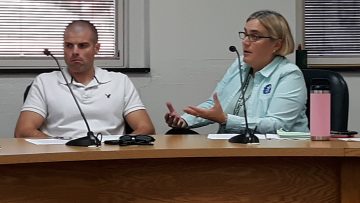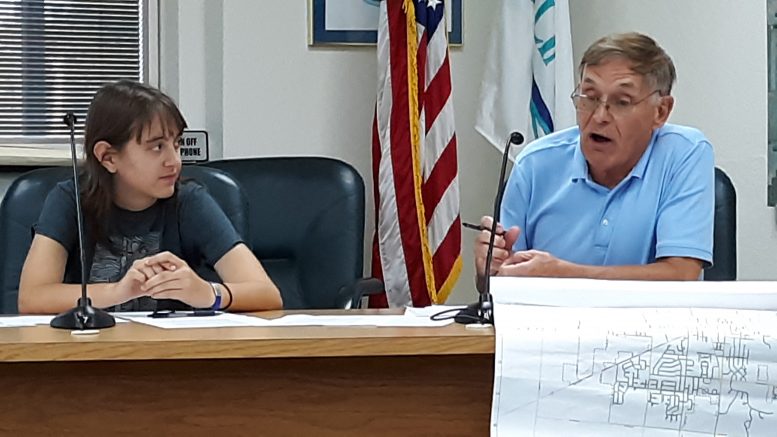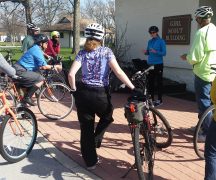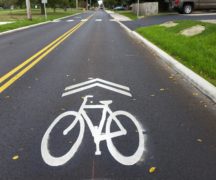By JAN LARSON McLAUGHLIN
BG Independent News
City groups looking at transportation and bicycle safety want to do more than just spin their wheels.
So on Monday evening, a joint meeting was held with the Bicycle Safety Commission and the City Council Transportation & Safety Committee. Together, the groups wanted to look at the two priorities involving bicycling that City Council selected in the new Community Action Plan.
After discussion, the groups decided on the more manageable goal of pursuing grants to fund a bike lane on Court Street. They also decided to further explore the more “sweeping goal” of creating bike friendly streets in the area of Clough, Scout Hamilton, Thurstin and South College streets.
Meanwhile, John Zanfardino, head of the council committee looking at bicycling in Bowling Green, said he continues to struggle with the seemingly opposing threads of the bicycling discussion.
One direction focuses on education of bicyclists and motorists, so they learn to better share city streets. The other focus is on creating infrastructure for bicyclists – whether that is the more expensive bike lanes or the less costly sharrows painted on roads.
“I’m a fan of Yay Bikes,” Zanfardino said of the Columbus-based organization that has worked with Bowling Green officials to better educate bicyclists and motorists.
“It has the benefit of being a low cost way of making the city safer for bikes,” he said.
Council member Daniel Gordon, also a member of the council committee, agreed that the Yay Bikes program was helpful. But he questioned the Yay Bikes conclusion that Bowling Green only needs education – not biking infrastructure.
“Your streets are fine. You don’t need bike lanes. You don’t need infrastructure,” Gordon said of the Yay Bikes’ observations.
“That’s certainly not the sentiment I’m hearing from folks in town,” Gordon said.
The communities of Toledo, Sylvania and Perrysburg are working on biking infrastructure, he said. So it seems strange that a college town like Bowling Green would be veering away from bike lanes, Gordon said.
“Residents have been calling for bike lanes for decades,” he said. “I think it’s well past time for us to make further efforts.”
While people who bicycle a lot in the city are comfortable sharing the road with motorized vehicles, many people don’t have that comfort so they just don’t bike, he said.
It seems, Gordon and others have concluded, that the momentum for bikes lanes has stalled in the city.
The expense of building bike lanes can be great. Oftentimes street width needs to be extended into yards, utility poles may need to be moved, or street parking may need to be prohibited.
“These two goals, if we push forward, are going to be expensive,” council member Greg Robinette said of the two CAP bicycling priorities.
Those expenses have led the focus to shift to educational opportunities, said Steve Langendorfer, head of the city bicycle safety commission. However, that does not mean an end to infrastructure efforts.
“The education is not meant to over-ride the engineering,” Langendorfer said.
The city has been offering several community “slow roll” bike rides, plus training for local third graders.
“Those have been particularly helpful encouraging people to get out on the streets and ride,” Langendorfer said of the community rides.
The commission has also identified the most “rideable streets” in the city, with a color-coded system.
The city has started with modest infrastructure – the sharrows on Fairview and Conneaut avenues, Langendorfer said.
“It tells motorists we’re trying to accommodate bicyclists as equals on the streets,” he said.
Most streets can’t accommodate bike lanes without huge expenses, he added.
The education efforts not only teach motorists to share the roads, but also teach bicyclists to obey traffic rules. Though Langendorfer said that in spite of complaints from motorists, research shows that bicyclists follow traffic rules as consistently as motorists in communities.
Langendorfer said he agrees with the Yay Bikes conclusion.
“We are for the most part, a friendly and rideable community,” he said.
Langendorfer also mentioned that the bicycle commission has been discussing how to make safe routes to schools in the city. He plans to talk with school district officials about studying the issue.

Bicycle safety commission members Tyson Richmond and Kristin Otley
Kristen Otley, the city’s park and recreation director and a member of the bicycle safety commission, cautioned that grants aren’t easy to come by, and the city cannot afford widespread bike infrastructure.
“We’re never going to have them everywhere,” she said of bike lanes.
Zanfardino agreed that “the cost has been extremely prohibitive” for bike infrastructure.
The two groups agreed to seek grant funding to create a bike lane on East Court Street, connecting the downtown and the BGSU campus.
Gordon supported the effort. “That’s what people want to see,” he said, adding that townspeople just want to see some efforts made.
Zanfardino agreed. “It’s one street, but I think it would be truly significant.”
Mayor Dick Edwards said BGSU President Rodney Rogers recently announced plans for an esplanade where Court Street ends into the campus, and where the administration building will be torn down. So the bike lanes would be a perfect addition, Edwards said.
Council member Bruce Jeffers, while supportive of the bike lane link between campus and downtown, questioned where bicyclists would go when the bike lanes end at North Main Street. That is a busy street not considered bike-friendly.
“Where are they going to go from downtown,” he asked.




